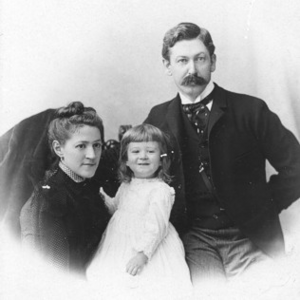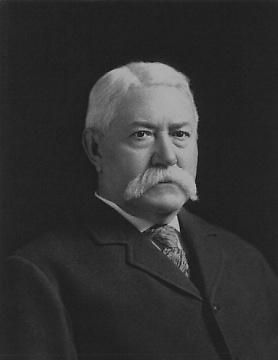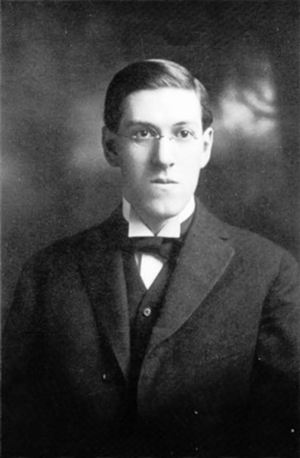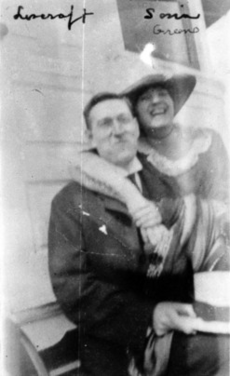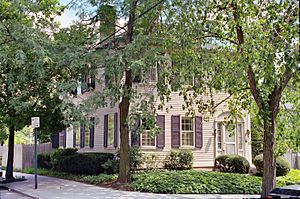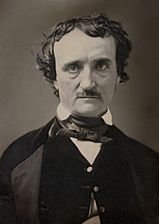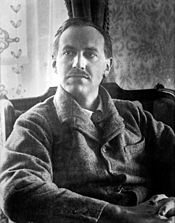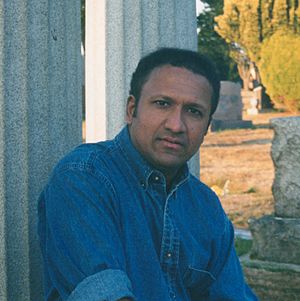H. P. Lovecraft facts for kids
Quick facts for kids
H. P. Lovecraft
|
|
|---|---|
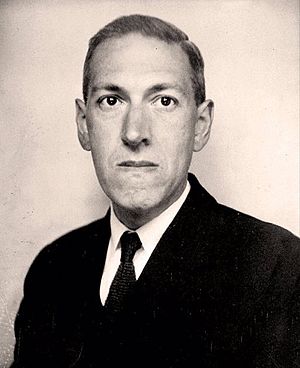
Lovecraft in 1934
|
|
| Born | Howard Phillips Lovecraft August 20, 1890 Providence, Rhode Island, U.S. |
| Died | March 15, 1937 (aged 46) Providence, Rhode Island, U.S. |
| Resting place | Swan Point Cemetery, Providence 41°51′14″N 71°22′52″W / 41.854021°N 71.381068°W |
| Pen name |
|
| Occupation |
|
| Genre | Lovecraftian horror, weird fiction, horror fiction, science fiction, gothic fiction, fantasy |
| Literary movement |
|
| Years active | 1917–1937 |
| Notable works |
|
| Spouse | |
| Signature | |
Howard Phillips Lovecraft (born August 20, 1890 – died March 15, 1937) was an American writer. He wrote stories that mixed weird, science, fantasy, and horror fiction. He is most famous for creating the Cthulhu Mythos, a world of strange and ancient beings.
Lovecraft was born in Providence, Rhode Island, and lived most of his life in New England. His father became ill in 1893. Lovecraft lived comfortably until his grandfather died, and the family lost much of its money. He then lived with his mother, facing money problems, until she also became ill in 1919.
He started writing for a group called the United Amateur Press Association. In 1913, a letter he wrote to a magazine led him to start writing for "pulp magazines." These were cheap magazines that printed exciting stories. He became a part of the science fiction community and published many stories.
Lovecraft moved to New York City and married Sonia Greene in 1924. He became the center of a group of writers known as the "Lovecraft Circle." They helped him get published in Weird Tales, which became his main publisher. Life in New York was hard for Lovecraft, both mentally and financially. He returned to Providence in 1926. There, he wrote some of his most famous works, like The Call of Cthulhu and At the Mountains of Madness. He continued writing for 11 more years until he died at age 46.
Lovecraft's stories often explored the idea of cosmicism. This was his personal belief that humans are tiny and unimportant in the huge universe. He mixed fantasy and science fiction to show how fragile human importance is. His stories were often set in a made-up version of New England. The idea of civilizations falling apart was also a big part of his work. Lovecraft's early political ideas were traditional. He also held some unfair views about different groups of people for much of his life. After the Great Depression, his views changed, and he became a socialist.
Lovecraft never earned enough money from his writing to support himself. He was not well-known during his lifetime and mostly published in pulp magazines. However, in the 1970s, people started to study his work more. Now, he is seen as one of the most important horror writers of the 20th century. Many books, movies, and games have been inspired by his ideas. The Cthulhu Mythos, which uses Lovecraft's characters and settings, grew from these inspired works.
Contents
Lovecraft's Life Story
Growing Up and Family Challenges
Howard Phillips Lovecraft was born on August 20, 1890, in his family home in Providence, Rhode Island. He was the only child of Winfield Scott Lovecraft and Sarah Susan Lovecraft. His mother's family was quite wealthy. In April 1893, his father became very ill and was admitted to a hospital. He died five years later in 1898. Lovecraft always believed his father's illness was due to stress and lack of sleep. It is not known if he was told the full truth about his father's condition.
After his father went to the hospital, Lovecraft lived with his mother, his two aunts, and his grandparents. His mother, Susie, was very protective of him. Lovecraft later said his mother was very sad after his father's illness. His grandfather, Whipple, became like a father to him. Lovecraft said his grandfather was the "center of my entire universe." Whipple often traveled for business but wrote letters to young Lovecraft. By age three, Lovecraft was already good at reading and writing.
Whipple encouraged Lovecraft to love books, especially classical literature and English poetry. He also told Lovecraft scary, original stories about "winged horrors" and "deep, low, moaning sounds." These stories likely came from Gothic novelists like Ann Radcliffe. During this time, Lovecraft discovered books like The Rime of the Ancient Mariner and One Thousand and One Nights.
His grandmother Robie died in 1896, which greatly affected Lovecraft. He said his family fell into "a gloom from which it never fully recovered." His mother and aunts wore black clothes, which "terrified" him. Around this time, Lovecraft, at about five and a half years old, started having bad nightmares. These nightmares later inspired his stories. He dreamed of creatures he called "night-gaunts," which he said looked like drawings by Gustave Doré. Thirty years later, these creatures appeared in his fiction.
Lovecraft wrote his first known stories at age seven. They were poems based on the Odyssey and other Greek and Roman myths. He later wrote that he was very interested in Greek and Roman gods as a child. He even briefly believed in them instead of his Christian upbringing. At age five, when told Santa Claus wasn't real, he asked why "God is not equally a myth?" By age eight, he became very interested in science, especially astronomy and chemistry.
In 1902, Lovecraft said astronomy became very important to his way of thinking. He started publishing a small newspaper called Rhode Island Journal of Astronomy. He printed it using a special method called hectograph. Lovecraft often missed elementary school due to health issues, but he had tutors at home. His friends described him as quiet but friendly to those who shared his love for astronomy. He would invite them to look through his telescope.
School and Money Troubles
By 1900, his grandfather Whipple's businesses were struggling, and the family's wealth slowly disappeared. They had to let go of their hired helpers. In 1904, Whipple's biggest business failed completely. He died a few months later at age 70. After his death, Lovecraft's mother could not afford to keep their large family home. Later that year, she and Lovecraft had to move to a smaller apartment.
Lovecraft called this period one of the hardest in his life. In the fall of 1904, he started high school. Like his earlier school years, Lovecraft was often out of school for long periods due to what he called "near breakdowns." However, he said he enjoyed high school and made a few close friends. He did well in school, especially in chemistry and physics. He also continued publishing his Rhode Island Journal of Astronomy and started the Scientific Gazette, which focused on chemistry. During this time, he wrote his first fictional works that would later become famous, such as "The Beast in the Cave" and "The Alchemist".
In 1908, before he would have graduated high school, Lovecraft had another serious health problem. The exact reasons are unknown. He later described it as a "nervous collapse" or "a sort of breakdown." He sometimes blamed it on the stress of high school, even though he enjoyed it. In another letter, he wrote, "I was and am prey to intense headaches, insomnia, and general nervous weakness which prevents my continuous application to any thing."
Lovecraft had planned to go to Brown University after high school, but he never graduated and never went to college. It's not clear if his illness was physical, mental, or both. A classmate said Lovecraft had "terrible tics" and would sometimes "up and jump" from his seat. Lovecraft himself admitted to having these movements as a child. In a letter about 1908, he said he "could hardly bear to see or speak to anyone, & liked to shut out the world by pulling down dark shades & using artificial light."
First Recognition as a Writer
Not much is known about Lovecraft's activities between late 1908 and 1913. Lovecraft said their money problems continued, and his uncle's failed business cost his mother a lot of their remaining wealth. A friend of his mother, Clara Hess, remembered a visit where Susie kept saying Lovecraft was "so hideous that he hid from everyone." Lovecraft, however, said his mother was "a positive marvel of consideration." A neighbor later said that what sounded like loud arguments between mother and son were actually them reading Shakespeare aloud, which they both enjoyed.
During this time, Lovecraft restarted his science newspapers. He tried to study organic chemistry, and his mother bought him expensive chemistry equipment. But Lovecraft found the math involved boring and it gave him headaches. His first poem not published by himself appeared in a local newspaper in 1912. It was called Providence in 2000 A.D. and imagined a future where English Americans were replaced by immigrants. He also wrote poems with unfair views about different races.
In 1911, Lovecraft started sending letters to the editors of pulp magazines like Argosy. In 1913, a letter he wrote criticizing a writer named Fred Jackson led him to become a famous writer. Lovecraft called Jackson's stories "trivial" and "coarse." He also wrote that Jackson's characters showed "delicate passions and emotions proper to negroes and anthropoid apes." This started a long argument in the magazine's letters section. Lovecraft's main opponent was John Russell, whose writing Lovecraft respected. This argument led Edward F. Daas, the editor of the United Amateur Press Association (UAPA), to invite Lovecraft and Russell to join. Lovecraft joined in April 1914.
New Beginnings and Sadness
Lovecraft spent most of the next ten years deeply involved in amateur journalism. He believed that amateur writing was better than writing for money in what he called "low-brow" publications. He saw amateur journalism as practice for a professional writing career.
In late 1914, Lovecraft became the head of the UAPA's Department of Public Criticism. He used this role to argue that old English language was better. He often criticized other UAPA writers for using "Americanisms" and "slang." These criticisms sometimes included unfair and prejudiced statements about immigrants changing the "national language." In mid-1915, Lovecraft was elected vice-president of the UAPA. Two years later, he became president. He chose other board members who mostly agreed with his views on British English. Another important event was the start of World War I. Lovecraft wrote many criticisms of the American government for not joining the war to protect England, which he saw as America's homeland.
In 1916, Lovecraft published his first short story, "The Alchemist," in the main UAPA journal. This was different from his usual poems. Encouraged by W. Paul Cook, another UAPA member and lifelong friend, Lovecraft started writing more prose stories. Soon after, he wrote "The Tomb" and "Dagon". Lovecraft said "The Tomb" was heavily influenced by Edgar Allan Poe's style. "Dagon" is seen as Lovecraft's first work that showed the ideas and themes he would become known for. In 1919, he published "Beyond the Wall of Sleep", his first science fiction story.
Lovecraft's term as UAPA president ended in 1918. In 1917, Lovecraft tried to join the United States Army. He passed the physical exam, but he told a friend that his mother threatened to do anything to prove he was unfit for service. After this, he tried to join the Rhode Island National Guard, but his mother used her family connections to stop him.
In the winter of 1918–1919, his mother, Susie, became very ill and went to live with her older sister. The exact nature of her illness is unclear. A neighbor recalled Susie describing "weird and fantastic creatures that rushed out from behind buildings." In March 1919, she was admitted to the same hospital where her husband had been. Lovecraft was very sad about this, writing that "existence seems of little value." He visited her often at the hospital.
In late 1919, Lovecraft started to go out more. After a time of staying isolated, he began joining friends on trips to writer gatherings. The first was a talk in Boston by Lord Dunsany, a writer Lovecraft admired. In early 1920, at a writer's convention, he met Frank Belknap Long, who became his closest friend. Dunsany's influence is clear in Lovecraft's 1919 stories, which are part of his Dream Cycle, like "The White Ship".
Later in 1920, Lovecraft began publishing the first Cthulhu Mythos stories. The Cthulhu Mythos is a term used by later writers for Lovecraft's stories that share ideas about humans being unimportant in the universe. They often have realistic settings and feature recurring strange beings and books. The poem "Nyarlathotep" and the short story "The Crawling Chaos" were written in late 1920. In early 1921 came "The Nameless City", the first clear Cthulhu Mythos story. It contains one of Lovecraft's most famous lines: "That is not dead which can eternal lie; And with strange aeons even death may die." That same year, he wrote "The Outsider", a story that has been interpreted in many ways, including as being about Lovecraft himself.
On May 24, 1921, Susie died in the hospital after surgery. Lovecraft was very sad at first, saying he wished his life would end. But later, he felt a sense of relief, as he could now live independently. His health also improved. He continued to attend amateur journalist conventions. At one such convention in July, Lovecraft met his future wife, Sonia Greene.
Marriage and Life in New York
Lovecraft's aunts did not approve of his relationship with Sonia. Lovecraft and Greene married on March 3, 1924. They moved to her apartment in Brooklyn, New York. Sonia believed he needed to leave Providence to succeed and was willing to support him. Greene, who had been married before, later said Lovecraft was a good partner, but she had to take the lead in their relationship. She thought Lovecraft's quiet nature came from his mother's strict upbringing. Lovecraft gained weight from his wife's cooking.
He loved New York and found a group of supportive friends in a club called the Kalem Club. They encouraged him to send stories to Weird Tales magazine. The editor, Edwin Baird, accepted many of Lovecraft's stories. The Kalem Club included writers like Henry Everett McNeil and James Ferdinand Morton Jr., and poet Reinhardt Kleiner.
In 1925, Sonia moved to Cleveland for a job opportunity. Lovecraft moved to a small apartment in Red Hook, which he found very uncomfortable. Later that year, Lovecraft joined the Kalem Club's regular members, including his friend Frank Belknap Long and bookseller George Willard Kirk. Samuel Loveman, who was Jewish, became a close friend of Lovecraft, even though Lovecraft had some unfair views about Jewish people.
Soon after they married, Greene lost her business and her money in a bank failure. Lovecraft tried to find regular jobs to support his wife, but he had no work experience. The publisher of Weird Tales offered Lovecraft the job of editor, but he refused because he did not want to move to Chicago. Farnsworth Wright became the new editor. Wright often rejected Lovecraft's stories. However, after Lovecraft's death, Wright accepted many of the stories he had originally turned down.
Sonia also became ill. After recovering, she moved to Cincinnati and then to Cleveland for her job, which required constant travel. Lovecraft felt like a failure in a city with many immigrants. His apartment was also robbed, leaving him with almost nothing. In August 1925, he wrote "The Horror at Red Hook" and "He". In "He," the narrator says, "My coming to New York had been a mistake; for whereas I had looked for poignant wonder and inspiration [...] I had found instead only a sense of horror and oppression." This showed how unhappy he was in New York. Around this time, he wrote the plan for "The Call of Cthulhu", which explored the idea of humanity's insignificance. He also wrote "Supernatural Horror in Literature", an important essay about horror. With money Sonia sent him, Lovecraft moved to a working-class area of Brooklyn Heights. By 1926, he had lost a lot of weight. He then left New York and returned to Providence.
Return to Providence and Final Years
Back in Providence, Lovecraft lived with his aunts in a "spacious brown Victorian wooden house" until 1933. He then moved to 66 Prospect Street, his last home. The time after his return to Providence saw him write some of his most famous works. These include The Dream-Quest of Unknown Kadath, The Case of Charles Dexter Ward, "The Call of Cthulhu", and The Shadow over Innsmouth. The first two stories are partly about his own life. Scholars say The Dream-Quest of Unknown Kadath is about his return to Providence. The Case of Charles Dexter Ward is partly about the city itself. Lovecraft also often edited and ghostwrote for other authors. He wrote The Mound and "Winged Death" for others. His client Harry Houdini praised him and tried to help Lovecraft get more work. But Houdini died in 1926, ending their plans. After returning to Providence, Lovecraft also started taking trips to old towns along the eastern coast during the summer.
In August, Robert E. Howard wrote a letter to Weird Tales praising Lovecraft's story "The Rats in the Walls". The editor sent the letter to Lovecraft, who wrote back positively. Soon, the two writers began a strong friendship through letters that lasted until Howard's death. Howard quickly became part of the Lovecraft Circle. This was a group of writers and friends connected by Lovecraft's many letters. He encouraged them to share stories and use each other's made-up creations.
Lovecraft was writing more and more work that earned him no money. He seemed calm about how his works were received, but he was very sensitive to criticism. He often gave up trying to sell a story after it was rejected once. For example, he wrote The Shadow over Innsmouth, which could have sold well, but he never tried to sell it. He even ignored publishers who asked if he had any novels ready. He had finished The Case of Charles Dexter Ward, but it was never typed up. A few years after Lovecraft moved back to Providence, he and his wife Sonia Greene, who had lived apart for a long time, agreed to a friendly divorce. Greene moved to California in 1933 and remarried in 1936. She did not know that Lovecraft had never officially signed the final divorce papers.
Because of the Great Depression, Lovecraft's political views changed. He started to support socialism. He believed socialism was a good middle ground between what he saw as the harmful ideas of capitalists and Marxists. He supported Franklin D. Roosevelt for president. He thought Roosevelt was trying to find a middle path between conservatives and revolutionaries.
In late 1936, his book The Shadow over Innsmouth was published as a paperback. Only 400 copies were printed. Lovecraft was unhappy because the book had many errors. It sold slowly, and only about 200 copies were bound. The other 200 were destroyed when the publisher went out of business. By this time, Lovecraft's writing career was ending. After writing his last original short story, "The Haunter of the Dark", he said that the bad reception of At the Mountains of Madness had "more than anything to end my effective fictional career." His worsening mental and physical health made it impossible for him to keep writing stories.
On June 11, Robert E. Howard died. This deeply affected Lovecraft, who wrote a short tribute called "In Memoriam: Robert Ervin Howard." Lovecraft's own health was getting worse. He was suffering from an illness he called "grippe."
Lovecraft was afraid of doctors, so he was not examined until a month before he died. He was diagnosed with cancer of the small intestine. He stayed in the hospital and was in constant pain until he died on March 15, 1937, in Providence. Because he was always curious about science, he kept a diary of his illness until he could no longer hold a pen. Lovecraft's name is on his family's monument. In 1977, fans put up a headstone for him in Swan Point Cemetery. It has his name, birth and death dates, and the phrase "I AM PROVIDENCE"—a line from one of his letters.
Lovecraft's Beliefs
Political Views
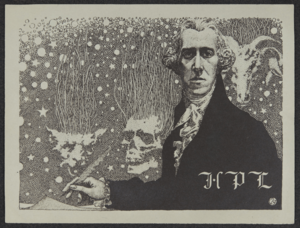
Lovecraft started his life with very traditional political views, likely from his upbringing. His family supported the Republican Party. Lovecraft himself admired England and supported the British monarchy. He was against democracy and believed the United States should be ruled by a group of wise, educated people. This idea stayed with him until the late 1920s. During World War I, he strongly supported England against its enemies. Many of his early poems and essays in his amateur journal, The Conservative, were about political topics.
The Great Depression made Lovecraft rethink his political ideas. At first, he thought wealthy people would act like his ideal rulers and solve America's problems. When this didn't happen, he became a socialist. This change happened because he saw how much the Depression was hurting American society. He was also influenced by the growing popularity of socialism in the 1930s. One of Lovecraft's main socialist ideas was that he was against Soviet Marxism. He thought a Marxist revolution would destroy American civilization. Lovecraft believed that a group of smart, educated people needed to lead to save America. He described his ideal government in his 1933 essay "Some Repetitions on the Times." In this essay, he suggested that the government should control how resources are shared. He also wanted fewer working hours, higher wages, and support for the unemployed and elderly. He often used the word "fascism" to describe this type of government, but it was different from the actual meaning of that word.
Lovecraft had mixed feelings about the political leaders of his time. He strongly supported Franklin D. Roosevelt. He saw Roosevelt as trying to find a middle path between traditional thinkers and revolutionaries, which he liked. He thought Roosevelt should have made more progressive changes, but he believed the New Deal was the only realistic option for reform at that time. He thought voting for other left-wing politicians would be a waste. Internationally, like many Americans, he first supported Adolf Hitler. He thought Hitler would protect German culture. However, he believed Hitler's ideas about race should be based on culture, not family background. There is evidence that Lovecraft started to oppose Hitler at the end of his life. A neighbor told Lovecraft about seeing Jewish people being mistreated in Germany. Lovecraft and his aunt were very upset by this. After this, he stopped talking about Hitler.
Atheism
Lovecraft was an atheist. He explained his views on religion in his 1922 essay "A Confession of Unfaith." In it, he described how he moved away from his parents' Protestantism to atheism as an adult. He was raised in a religious family and learned about the Bible and Santa Claus at age two. He accepted both. Later, he read Grimms' Fairy Tales and One Thousand and One Nights, preferring the latter. He even pretended to be "Abdul Alhazred," a name he later used for a character in his stories. Lovecraft briefly believed in Greek and Roman gods. His first moment of doubt happened before his fifth birthday. He questioned if God was a myth after learning Santa Claus wasn't real. In 1896, he learned about Greek and Roman myths and became "a genuine pagan."
This changed in 1902 when Lovecraft discovered space. He later called this the most important moment in his life. He started studying astronomy and wrote about his observations in the local newspaper. Before his thirteenth birthday, he believed that humans were not permanent. By age seventeen, he had read books that supported his view. Lovecraft stopped writing positively about progress and developed his later cosmic philosophy. Even though he liked science, he didn't like realistic literature. So, he became interested in fantasy stories. Lovecraft became pessimistic when he started amateur journalism in 1914. The Great War seemed to confirm his views. He started to dislike the idea of philosophical idealism. Lovecraft discussed his pessimism with his friends, which helped him strengthen his ideas. Reading writers like Friedrich Nietzsche also helped him. At the end of his essay, Lovecraft said all he wanted was to disappear. He was ready to let go of any false beliefs he still had.
Views on Race
Lovecraft's views on race are the most debated part of his legacy. He made many negative comments about non-Anglo-Saxon races and cultures in his works. Scholars say these views were common in American society at the time, especially in New England. As he got older, his ideas about race changed into a kind of classism. He thought the "superior race" included all those who were educated and cultured. Lovecraft was a white supremacist. However, he didn't think all white people were equally great. He especially admired English people and those of English descent. In his early writings and letters, he argued for strict separation of races to protect culture. He used negative descriptions of various races in his journalism and letters. In some of his stories, he used made-up creatures to represent mixing of human races. This is clear in his portrayal of the Deep Ones in The Shadow over Innsmouth. Their mixing with humans is shown as something that harms the town of Innsmouth and the main character.
At first, Lovecraft showed some understanding for minority groups who adopted Western culture. He even married a Jewish woman whom he saw as "well assimilated." By the 1930s, Lovecraft's views on different ethnic groups and races became more moderate. He supported ethnic groups keeping their own cultures. For example, he thought that "a real friend of civilisation wishes merely to make the Germans more German, the French more French, the Spaniards more Spanish, & so on." This was a change from his earlier support for cultural assimilation. His views changed partly because he experienced different cultures through his travels and friends. His travels led him to write positively about Québécois and First Nations cultural traditions in his travelogue of Quebec. However, this did not mean he completely got rid of his unfair prejudices.
What Influenced Lovecraft
Lovecraft's interest in weird stories began when he was a child. His grandfather, who liked Gothic stories, would tell him his own scary tales. Lovecraft's childhood home had a large library with classic books, science books, and early weird fiction. At age five, Lovecraft enjoyed reading One Thousand and One Nights. A year later, he was reading Nathaniel Hawthorne. He was also influenced by travel books by John Mandeville and Marco Polo. These travel stories might have also influenced how Lovecraft described characters and places in his later works. For example, there are similarities between the powers of Tibetan magicians in The Travels of Marco Polo and the powers in "The Dunwich Horror".
One of Lovecraft's most important influences was Edgar Allan Poe. Lovecraft called Poe his "God of Fiction." Lovecraft discovered Poe's stories when he was eight years old. His early works were greatly influenced by Poe's writing style. He also used Poe's idea of "unity of effect" in his stories, where everything in a story works together to create one feeling. Also, At the Mountains of Madness directly quotes Poe and was influenced by The Narrative of Arthur Gordon Pym of Nantucket. Both stories explore how language might not be able to fully express meaning. In 1919, Lovecraft discovered the stories of Lord Dunsany. This moved his writing in a new direction, leading to a series of fantasy stories. Lovecraft always said Dunsany had the biggest impact on his writing career. The first result of this influence was the Dream Cycle, a series of fantasies set in a dreamworld. By 1930, Lovecraft decided he would no longer write Dunsany-style fantasies, saying that style didn't feel natural to him. He also read and was influenced by Arthur Machen and Algernon Blackwood in the 1920s.
Besides horror writers, Lovecraft was also influenced by the Decadents, the Puritans, and the Aesthetic movement. Barton Levi St. Armand, a professor at Brown University, said these three influences shaped Lovecraft as a writer. He saw this in Lovecraft's stories and letters. Lovecraft actively tried to appear like an old New England gentleman in his letters. His interest in decline came from his readings of Edgar Allan Poe. The idea of cosmic decline was Lovecraft's response to the Aesthetic Movement and the 19th-century Decadents. St. Armand describes it as a mix of Puritan thought and the Decadent worldview. This idea creates a contrast in his stories, especially in "The Horror at Red Hook" and "The Music of Erich Zann".
Science also inspired Lovecraft. Advances in biology, astronomy, geology, and physics helped him see humans as small and powerless in a materialistic universe. Lovecraft was a keen amateur astronomer from a young age. He often visited the Ladd Observatory in Providence and wrote many astronomy articles for his personal journal and local newspapers. Lovecraft's scientific views led him to share his philosophical ideas through his stories. These ideas became known as cosmicism. Cosmicism became more pessimistic with his creation of the Cthulhu Mythos. This is a fictional universe with alien gods and horrors. The term "Cthulhu Mythos" was probably created by later writers after Lovecraft died. In his letters, Lovecraft jokingly called his made-up mythology "Yog-Sothothery".
Dreams played a big role in Lovecraft's writing. While most of his stories were not direct transcriptions of dreams, many were influenced by dreams. In his letters, Lovecraft often compared his characters to dreamers. They are shown as helpless, like someone having a nightmare. His stories also have dreamlike qualities. The Randolph Carter stories blur the line between dreams and reality. The dreamlands in The Dream-Quest of Unknown Kadath are a shared dreamworld that sensitive dreamers can enter. In "The Silver Key", Lovecraft mentions "inward dreams," suggesting there are also "outward dreams." Lovecraft's writing style needed both realism and dreamlike elements.
Main Ideas in Lovecraft's Stories
Cosmicism: Humans Are Small
The main idea in Lovecraft's stories is cosmicism. This is a philosophy that says humans are a tiny, unimportant part of the universe. Even though it sounds sad, Lovecraft saw himself as a "cosmic indifferentist." This means he believed the universe doesn't care about humans. In his stories, humans are often controlled by powerful beings and cosmic forces. But these forces are not evil; they are simply uncaring towards humanity. He believed in a meaningless, mechanical universe that humans could never fully understand. There was no room for beliefs that couldn't be proven by science. Lovecraft first wrote about this idea in 1921. But he didn't fully put it into his stories until five years later. Stories like "Dagon" and "Beyond the Wall of Sleep" show early versions of this idea. But most of his early tales don't explore it deeply. "Nyarlathotep" suggests that human civilization falling apart is like the universe falling apart. "The Call of Cthulhu" makes this idea even stronger. In it, Lovecraft introduces the idea of alien influences on humanity, which became a key part of all his later works. In these stories, Lovecraft shows cosmicism by confirming what characters already suspect, rather than revealing something new. His main characters don't learn they are unimportant; they already know it, and an event just proves it to them.
The Dangers of Too Much Knowledge
Lovecraft's stories show his mixed feelings about knowledge. This appears as the idea of forbidden knowledge. In his stories, happiness comes only from not knowing certain things. Trying to learn what is not meant to be known leads to harm and mental danger. This idea connects with other concepts. For example, the idea that visible reality is just an illusion hiding a horrific true reality. It also links to the idea of ancient civilizations that have a bad influence on humanity, and to cosmicism. Lovecraft believed that knowing too much about oneself could lead to ruin. Those who seek this knowledge would realize how unimportant they are in the universe. They would not be able to handle this truth. Lovecraftian horror comes not from outside events, but from the mental impact that knowledge has on the main characters. "The Call of Cthulhu," The Shadow over Innsmouth, and The Shadow Out of Time feature characters who experience both outside and inside horror by gaining self-knowledge. The Case of Charles Dexter Ward also shows this. A main idea is the danger of knowing too much about one's family history. Charles Dexter Ward, the main character, researches his family history. This leads to him going mad and destroying himself.
Civilization Falling Apart
For much of his life, Lovecraft was focused on the ideas of decline and decadence. He believed that Western civilization was slowly falling apart. In the 1920s, Lovecraft learned about the work of Oswald Spengler, a German thinker. Spengler's sad idea that the modern West was decaying became a key part of Lovecraft's view against modern ideas. Spengler's images of civilizations rising and falling are a main theme in At the Mountains of Madness. S. T. Joshi, a scholar, says that Spengler's ideas are central to Lovecraft's political and philosophical thoughts. According to Joshi, the idea of decline is the single idea that connects all of Lovecraft's personal philosophy. The main influence from Spengler was his view that politics, money, science, and art are all connected parts of a civilization. This made Lovecraft pay more attention to current political and economic events after 1927. Lovecraft had already developed his idea of Western decline, but Spengler gave it a clear structure.
Science in Lovecraft's Stories
Lovecraft changed supernatural horror. He moved it away from human problems to focus on cosmic ones. He combined parts of supernatural fiction that he thought were scientifically possible with science fiction. This required understanding both supernatural horror and the science of his time. Lovecraft used this knowledge to create stories that often mentioned new scientific ideas. Starting with "The Shunned House", Lovecraft increasingly added ideas from Einsteinian science and his own materialism into his stories. This became stronger with "The Call of Cthulhu," where he showed alien influences on humanity. This continued throughout the rest of his writing career. "The Colour Out of Space" is seen as the peak of this trend. It shows an alien lifeform so strange that it cannot be explained by the science of the time.
Another part of this was his repeated use of mathematics. He used it to make his creatures and settings seem more alien. Tom Hull, a mathematician, says this made his stories more scary and strange. He believes Lovecraft used math because of his childhood interest in astronomy and his adult knowledge of non-Euclidean geometry. Another reason was his reaction to the scientific discoveries of his day. These discoveries made him believe that humanity's main way of understanding the world was no longer reliable. Lovecraft's use of math in his stories helps explain supernatural elements with scientific ideas that existed in his time. "The Dreams in the Witch House" and The Shadow Out of Time both do this. The first uses a witch and her familiar, while the second uses the idea of mind transference. These elements are explained using scientific theories that were common during Lovecraft's life.
Lovecraft Country: A Fictional Setting
The setting is very important in Lovecraft's stories. Lovecraft Country is a made-up version of New England. It is the main place for his mythos. It shows the history, culture, and folklore of the region, as Lovecraft saw them. These features are made bigger and changed to create a good setting for his stories. The names of places in the region were directly influenced by real places. This was done to make them seem more real. Lovecraft's stories use their connection to New England to create a sense of fear. Lovecraft was mainly inspired by cities and towns in Massachusetts. However, the exact location of Lovecraft Country changes depending on what Lovecraft needed for his stories. He started with areas he found interesting. Then, he changed and exaggerated them with made-up names. For example, Lovecraft based Arkham on the town of Oakham. He expanded it to include a nearby landmark. Its location was moved because Lovecraft decided it would have been destroyed by the recently built Quabbin Reservoir. This is hinted at in "The Colour Out of Space." The "blasted heath" is covered by water when a fictional version of the reservoir is created. Similarly, Lovecraft's other towns were based on other places in Massachusetts. Innsmouth was based on Newburyport, and Dunwich was based on Greenwich. The unclear locations of these towns also helped Lovecraft create a certain mood in his stories. He believed a mood could only be created through reading.
Lovecraft's Impact and Legacy

Lovecraft was not very well known during his lifetime. While his stories appeared in popular pulp magazines like Weird Tales, not many people knew his name. However, he regularly wrote letters to other writers like Clark Ashton Smith and August Derleth, who became his friends. This group was called the "Lovecraft Circle." They often used Lovecraft's ideas in their own writings, and he encouraged them. He also borrowed ideas from them. For example, he used Clark Ashton Smith's character Tsathoggua in The Mound.
After Lovecraft died, the Lovecraft Circle continued. August Derleth started Arkham House with Donald Wandrei to keep Lovecraft's works in print. Derleth added to Lovecraft's ideas, which caused some debate. Lovecraft saw his alien gods as just plot devices. But Derleth created a whole universe with a war between good Elder Gods and evil Outer Gods like Cthulhu. Derleth's Cthulhu Mythos stories also connected different gods to the four elements of fire, air, earth, and water. This was different from Lovecraft's original ideas. However, Derleth owned Arkham House, which gave him a lot of power in Lovecraft studies until he died.
Lovecraft's works have influenced many writers and artists. Stephen King has said Lovecraft was a big influence on his horror stories. As a child, King found a book of Lovecraft's works, which inspired him. King argues that all horror works written after Lovecraft were influenced by him. In comics, Alan Moore said Lovecraft greatly influenced his graphic novels. Film director John Carpenter's movies include direct references to Lovecraft's stories. They also use Lovecraftian styles and themes. Guillermo del Toro has also been influenced by Lovecraft's works.
The first World Fantasy Awards were held in Providence in 1975. The theme was "The Lovecraft Circle." Until 2015, winners received a statue of Lovecraft. In November 2015, it was announced that the World Fantasy Award trophy would no longer be based on H. P. Lovecraft due to his views on race. After this, The Atlantic magazine commented, "In the end, Lovecraft still wins—people who've never read a page of his work will still know who Cthulhu is for years to come, and his legacy lives on in the work of Stephen King, Guillermo del Toro, and Neil Gaiman."
In 2016, Lovecraft was added to the Museum of Pop Culture's Science Fiction and Fantasy Hall of Fame. Three years later, Lovecraft and other mythos authors won the 1945 Retro-Hugo Award for Best Series for their contributions to the Cthulhu Mythos.
Studying Lovecraft's Work
Starting in the early 1970s, scholars began to study Lovecraft's life and works. This field, called Lovecraft studies, aimed to show Lovecraft as an important American writer. This began with Derleth's efforts to save and share Lovecraft's stories, non-fiction, and letters through Arkham House. However, these early editions sometimes had errors and misunderstood Lovecraft's ideas. After Derleth died in 1971, the study of Lovecraft changed. There was a push to write a full biography of Lovecraft. L. Sprague de Camp, a science fiction scholar, wrote the first major one in 1975. This biography was criticized by early Lovecraft scholars for not being very academic and for not being sympathetic to Lovecraft. Despite this, it helped Lovecraft become known to more mainstream American literary critics. In the late 1970s and early 1980s, there was a split in the field. Some scholars wanted to interpret Lovecraft through fantasy literature, while newer scholars wanted to focus more on all of his writings.
The 1980s and 1990s saw more growth in the field. The 1990 H. P. Lovecraft Centennial Conference and the reprinting of older essays helped create a base for future studies. The 1990 centennial also saw the installation of the "H. P. Lovecraft Memorial Plaque" in a garden near John Hay Library. In 1996, S. T. Joshi wrote his own biography of Lovecraft. This book received good reviews and became the main biography in the field. It has since been replaced by his larger book, I am Providence, published in 2010.
Lovecraft's growing reputation has led to his works getting more attention from classic book publishers and scholarly fans. His works have been published by several different series of literary classics. Penguin Classics published three volumes of Lovecraft's works between 1999 and 2004. Barnes & Noble published their own volume of Lovecraft's complete fiction in 2008. The Library of America published a volume of Lovecraft's works in 2005. The publishing of these books showed a change in how Lovecraft was seen. He was now considered part of the Western canon of important writers. Meanwhile, the NecronomiCon Providence convention started in 2013. It is a convention for fans and scholars that discusses Lovecraft and weird fiction. It is held on the weekend of Lovecraft's birthday. In July of that year, the Providence City Council named the "H. P. Lovecraft Memorial Square" and put up a sign near his old homes.
Music Inspired by Lovecraft
Lovecraft's fictional Mythos has influenced many musicians, especially in rock and heavy metal music. This started in the 1960s with the psychedelic rock band H. P. Lovecraft. They released albums in 1967 and 1968. Later songs by other artists were titled after Lovecraft stories, like "The White Ship" and "At the Mountains of Madness." Extreme metal has also been influenced by Lovecraft. This is seen in band names and album content. It began in 1970 with Black Sabbath's first album, which had a song called "Behind the Wall of Sleep," named after Lovecraft's 1919 story. Heavy metal band Metallica was also inspired by Lovecraft. They recorded a song called "The Call of Ktulu," inspired by "The Call of Cthulhu." They also had a song based on The Shadow over Innsmouth called "The Thing That Should Not Be." These songs directly quote Lovecraft's works. Some scholars say there are similarities between the music described in Lovecraft's stories and the style of black metal. They point to the "animalistic" sounds of black metal vocals. The use of dark, mysterious elements is also a common theme. In terms of mood, both Lovecraft's works and extreme metal focus on creating a strong, negative feeling.
Lovecraft's Influence on Games
Lovecraft has also influenced gaming, even though he didn't like games himself. Chaosium's tabletop role-playing game Call of Cthulhu, released in 1981, was one of the first games to use Lovecraft's ideas heavily. It includes a game mechanic where characters can go insane from seeing cosmic horrors. This idea later appeared in other tabletop and video games. In 1987, another Lovecraftian board game, Arkham Horror, was released. While few Lovecraftian board games came out between 1987 and 2014, there was a rapid increase after 2014. This might be because Lovecraft's work entered the public domain (meaning anyone can use it) and because board games became more popular. Few video games are direct adaptations of Lovecraft's works. However, many video games have been inspired by him. Call of Cthulhu: Dark Corners of the Earth, a Lovecraftian first-person video game, was released in 2005. It is loosely based on The Shadow over Innsmouth and The Shadow Out of Time. These adaptations often focus more on Lovecraft's monsters and making them into games, rather than his main idea of human insignificance.
Lovecraft's Letters
Lovecraft is mostly known for his weird fiction stories. But most of his writing is actually made up of many letters about different topics. These topics ranged from weird fiction and art criticism to politics and history. Scholars believe Lovecraft wrote 100,000 letters in his lifetime, and about 20,000 of them still exist. He wrote these letters to other writers and members of the amateur press. He started writing them because he was involved in amateur journalism. He often included funny parts in these letters. He would sometimes pretend to be an 18th-century gentleman and sign with fake names like "Grandpa Theobald" and "E'ch-Pi-El." According to S. T. Joshi, the most important letters were those written to Frank Belknap Long, Clark Ashton Smith, and James F. Morton. Joshi says these letters are important because of what they contained. Lovecraft often debated many ideas with Long. His letters to Clark Ashton Smith focused on weird fiction. Lovecraft and Morton discussed many scholarly topics in their letters. Joshi called their exchange the "single greatest correspondence Lovecraft ever wrote."
See also
 In Spanish: H. P. Lovecraft para niños
In Spanish: H. P. Lovecraft para niños
- Category:H. P. Lovecraft scholars


